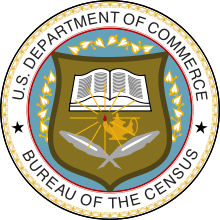1990 United States Census
| Twenty-first Census of the United States | |
|---|---|
|
U.S. Census Bureau Seal | |
|
Census Logo | |
| General information | |
| Country | United States |
| Date taken | April 1, 1990 |
| Total population | 248,709,873 |
| Percent change |
|
| Most populous state |
California 29,760,021 |
| Least populous state |
Wyoming 453,588 |
The Twenty-first United States Census, conducted by the Census Bureau, determined the resident population of the United States to be 248,709,873, an increase of 9.8 percent over the 226,545,805 persons enumerated during the 1980 Census.[1]
Approximately 16 percent of households received a "long form" of the 1990 census, which contained over 100 questions. Full documentation on the 1990 census, including census forms and a procedural history, is available from the Integrated Public Use Microdata Series.
It was the first census to designate "Native Hawaiian and Other Pacific Islander" as a racial group separate from Asians.
To increase black participation in the 1990 United States Census, the bureau recruited Bill Cosby, Magic Johnson, Alfre Woodard, and Miss America Debbye Turner as spokespeople.[2] The Integrated Public Use Microdata Series. Aggregate data for small areas, together with electronic boundary files, can be downloaded from the National Historical Geographic Information System. ≠
State rankings
| |
|
1980 Census |
1990 Census |
|
change |
|---|---|---|---|---|---|
| 1 | |
23,667,764 | 29,760,021 | |
|
| 2 | |
17,557,000 | 17,990,455 | |
|
| 3 | |
14,228,000 | 16,986,510 | |
|
| 4 | |
9,739,000 | 12,937,926 | |
|
| 5 | |
11,867,000 | 11,881,643 | |
|
| 6 | |
11,419,000 | 11,430,602 | |
|
| 7 | |
10,797,000 | 10,847,115 | |
|
| 8 | |
9,259,000 | 9,295,297 | |
|
| 9 | |
7,364,000 | 7,730,188 | |
|
| 10 | |
5,874,000 | 6,628,637 | |
|
| 11 | |
5,464,000 | 6,478,216 | |
|
| 12 | |
5,346,000 | 6,187,358 | |
|
| 13 | |
5,737,000 | 6,016,425 | |
|
| 14 | |
5,491,000 | 5,544,159 | |
|
| 15 | |
4,917,000 | 5,117,073 | |
|
| 16 | |
4,706,000 | 4,891,769 | |
|
| 17 | |
4,591,000 | 4,877,185 | |
|
| 18 | |
4,130,000 | 4,866,692 | |
|
| 19 | |
4,216,000 | 4,781,468 | |
|
| 20 | |
4,077,000 | 4,375,099 | |
|
| 21 | |
4,203,000 | 4,219,973 | |
|
| 22 | |
3,891,000 | 4,040,587 | |
|
| 23 | |
3,661,000 | 3,685,296 | |
|
| 24 | |
2,718,000 | 3,665,228 | |
|
| 25 | |
3,119,000 | 3,486,703 | |
|
| 26 | |
2,890,000 | 3,294,394 | |
|
| 27 | |
3,107,000 | 3,287,116 | |
|
| 28 | |
3,026,000 | 3,145,585 | |
|
| 29 | |
2,632,000 | 2,842,321 | |
|
| 30 | |
2,914,000 | 2,776,755 | |
|
| 31 | |
2,520,000 | 2,573,216 | |
|
| 32 | |
2,363,000 | 2,477,574 | |
|
| 33 | |
2,285,000 | 2,350,725 | |
|
| 34 | |
1,950,000 | 1,793,477 | |
|
| 35 | |
1,461,000 | 1,722,850 | |
|
| 36 | |
1,570,000 | 1,578,385 | |
|
| 37 | |
1,299,000 | 1,515,069 | |
|
| 38 | |
1,125,000 | 1,227,928 | |
|
| 39 | |
799,000 | 1,201,833 | |
|
| 40 | |
921,000 | 1,109,252 | |
|
| 41 | |
985,000 | 1,108,229 | |
|
| 42 | |
945,000 | 1,006,749 | |
|
| 43 | |
948,000 | 1,003,464 | |
|
| 44 | |
787,000 | 799,065 | |
|
| 45 | |
690,000 | 696,004 | |
|
| 46 | |
596,000 | 666,168 | |
|
| 47 | |
654,000 | 638,800 | |
|
| — | |
638,000 | 606,900 | |
|
| 48 | |
512,000 | 562,758 | |
|
| 49 | |
400,000 | 550,043 | |
|
| 50 | |
471,000 | 453,588 | |
|
| |
226,545,805 | 248,709,873 | 22,164,068 | 9.8% |
City rankings
| |
|
1980 Census |
1990 Census |
|
change |
|---|---|---|---|---|---|
| 1 | |
7,071,639 | 7,322,564 | |
|
| 2 | |
2,966,850 | 3,485,398 | |
|
| 3 | |
3,005,072 | 2,783,726 | |
|
| 4 | |
1,595,138 | 1,630,553 | |
|
| 5 | |
1,688,210 | 1,585,577 | |
|
References
- ↑ "Population and Area (Historical Censuses)" (PDF). United States Census Bureau. Archived (PDF) from the original on June 24, 2008. Retrieved June 20, 2008.
- ↑ Brown, Frank Dexter (February 1990). "The 1990 Census: Will Blacks Be Counted Out?". Black Enterprise (Earl G. Graves, Ltd.) 20 (7): 195. ISSN 0006-4165. Retrieved July 29, 2011.
External links
| Wikimedia Commons has media related to 1990 United States Census. |
- U.S. Census Bureau 1990 Census page
- Historic US Census data
- 1991 U.S Census Report Contains 1990 Census results
- Booknotes interview with Sam Roberts on Who We Are: A Portrait of America, June 19, 1994.
- step-by-step how to analyze the 1990 US Census Public Use Microdata Sample (PUMS) with free tools website
| |||||||||||||

